Nissim ELMALE, 1891 – 1944
The Elmale family: Despite her passing, she lives on through our stories
Introduction
We are four 9th grade students enrolled in the defense and citizenship class in junior high school in Pointoise. We participated in the CNRD (National Contest of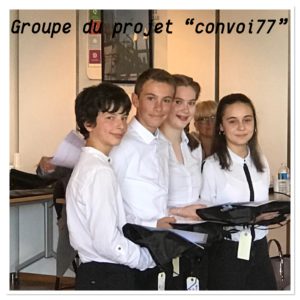 Resistance and Deportation) session 2018-2019. The theme was “Repression and deportation in France and Europe, 1939-1945, Spaces and History”. At the same time, we became involved in the European and citizen-oriented “Convoy77” project. We were given the opportunity to study the Elmale family, in particular to write the biography of the young Renée, who, together with both of her parents, was deported by the last of the large convoys on July 31, 1944. We have linked the two projects. Later in the biography, you can read about what we did for the joint CNRD 2019 project, which takes more of a fictional approach to Renée Elmale’s life. We were rewarded for our work with a working and remembrance trip to Poland, to Krakow and the Auschwitz-Birkenau camp.
Resistance and Deportation) session 2018-2019. The theme was “Repression and deportation in France and Europe, 1939-1945, Spaces and History”. At the same time, we became involved in the European and citizen-oriented “Convoy77” project. We were given the opportunity to study the Elmale family, in particular to write the biography of the young Renée, who, together with both of her parents, was deported by the last of the large convoys on July 31, 1944. We have linked the two projects. Later in the biography, you can read about what we did for the joint CNRD 2019 project, which takes more of a fictional approach to Renée Elmale’s life. We were rewarded for our work with a working and remembrance trip to Poland, to Krakow and the Auschwitz-Birkenau camp.
After two years of research that took us from Turkey, via Poland, to Israel, we are pleased to present the biography of the three members of the Elmale family: Renée, Donna and Nissim. We have also cross-referenced their personal history with the overall history of France and Europe during those terrible years.
In early July 1944, the Gestapo arrested the Elmales at Maisons-Laffitte, in the Seine-et-Oise department of France. They were then interned in the Drancy camp on July 7, 1944. The search record (n°24915) reveals that they had 12,173 francs on them, a considerable sum of money at the time. This leads us to believe that the family took all their savings with them, not knowing where they were to be taken. Who was this family, the only traces of which are only a few archived records and one single photograph, of Renée, found by the Shoah Memorial last year?
Renées “dossier de fouille” at Drancy
From Turkey to France
The story of the Elmale family begins in Turkey. Nissim Elmale was born on April 15, 1891 in Constantinople (now Istanbul), then capital of the Ottoman Empire. The son of Haïm Elmale and Louna Sévi, he had a sister named Sarah, who later married and became Sarah Nathan. Later on, in that same city, he met a young woman, Donna Sévi, born October 31, 1899, the daughter of Ezra Sévi and Rebecca Lévy. She was to become Nissim’s wife a few years later, but the exact date of their marriage is not known. Both of them were Jewish. In the 1920s, together with Nissim’s mother, who was a widow at the time, the couple left Turkey and emigrated to France. We assume that they fled their country as a result of the increasing persecution of the Jews.
During the First World War, the Ottoman Empire was allied to the Triple Alliance. Dissatisfied with the Treaty of Sèvres signed in 1920 by the Sultan, the Turkish army, led by Mustafa Kemal, orchestrated a coup d’état. During the First World War, the Ottoman Empire was allied to the Triple Alliance. Dissatisfied with the Treaty of Sèvres, which the Sultan had signed in 1920, the Turkish army, led by Mustafa Kemal, orchestrated a coup d’état. The Treaty of Lausanne, signed on July 24, 1923, replaced the Treaty of Sèvres, and the new state of Turkey was created and declared a Republic. A “Turkification” policy was then launched by President Mustafa Kemal, who wanted to build a Turkish nation-state. From the early days of the Republic, anti-Jewish press campaigns started to appear in certain regions, and Jews were compared to leeches and presented as war profiteers. Despite the fact that representatives of the Jewish community tried to defend themselves and to show their loyalty to the Turkish state, the persecution increased. As a result, in the 1920s, somewhere between a third and half of them emigrated to European countries.
A new life in France
Having safely arrived in France, they lived in Paris in 1925 and on September 9, 1926, they went to Enghien-les-Bains, no doubt to visit their future home (1). On November 1, 1928, on a maternity ward in the twelfth district of Paris, little Renée Fanny Elmale was born. Since she was born in France, she was a French citizen (2). The family then moved to Enghien-les-Bains, a town in the Seine et Oise department, about 7 miles (11 km) north of Paris. They lived at 4 bis Villa de la Croix-Blanche, in an old villa of nearly 11000 square feet, divided into several apartments (3).
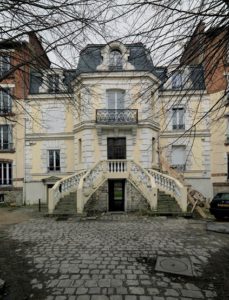
Villa de la Croix-Blanche
The year 1933 arrived, one that was to be a dramatic turning point for the future of Germany and the world. On January 30, 1933, Adolf Hitler was appointed Chancellor of the Reich by Marshal Paul von Hindenburg. His rise to power was spectacular, since barely two months later, following the Reichstag fire, he was granted sole authority for a period of four years. From then on, the man who had written Mein Kampf in 1925, a book in which he set out his ideas about racial theory and Nazi domination of the world, quickly established himself as a dictator whose policies were anti-Semitic, racist and totalitarian. Between then and September 1939, Nazi violence escalated, there were widespread repressions against opponents, and Jews were increasingly marginalized. The first Nazi concentration camp was opened in Dachau in March 1933, initially intended to imprison German political opponents of the Nazi regime, such as communists and social democrats.
Nissim’s mother, Louna Elmale, née Sévi, died on February 19, 1937 in Enghien-les-Bains at the age of 66 (4).
We presume that Renée Elmale went to the Ormesson “2” school in about 1935. This elementary school, which was at the time a girls’ school, was about ten minutes from the Elmales’ home. We have no proof to date that Renée was actually registered there, however.
Nissim was as a fairground worker and his wife did not work outside the home. Unfortunately, we have been unable to find any more information about their life in Enghien-les-Bains. At the Shoah Memorial in Paris and later at the National Museum of Auschwitz-Birkenau, we found the only portrait of Renée (5). It is a school photo from the 1940s, with a painted background. In it, we see a charming, smiling young girl. No photos of Nissim and Donna have been found. As part of the CNRD project, we used a fictional photo to represent them, based on whatever similarities we could find. For Nissim, we chose an image of a Jewish fairground worker who had left Turkey for France in the 1920s and had been deported to Auschwitz. For Donna, we found a photo of a Turkish Jewish woman in her forties. These images are just representative examples, since no actual photos of them are available.
Photo used to represent Nissim Elmale
Photo used to represent Donna Elmale
On 1 September 1939, the Wehrmacht regime invaded Poland. The invasion was conceived and coordinated by Adolf Hitler, who wanted to dominate all of Europe. Two days later, Great Britain and France declared war on Nazi Germany. This marked the beginning of the Second World War. The Nazis began their crackdowns on Polish Jews, and many of them were confined to the ghettos.
Nothing could stop Adolf Hitler. On April 27, 1940, his right-hand man, Heinrich Himmler, the Reichsführer (Leader) of the SS, gave the order for the construction of a concentration camp named Auschwitz at Oswiecim, a town in southern Poland..
Following the Battle of France in the months of May and June, 1940, a defeated France signed the Armistice with the Reich on June 22, 1940. The text of the Armistice stipulated that the occupied northern part of France was to be separated from the unoccupied southern part by a demarcation line extending from the Pyrenees to the Swiss border. The occupied zone was attached to the Reich and the non-occupied zone to the Vichy regime led by Marshal Pétain, Head of the French State. it was he who decided to collaborate with the Nazi regime.
In the 1940s, Enghien-les-Bains was one of the towns in the Paris area that was most affected by the Occupation. It was the Germans’ departmental Kommandantur (headquarters), from which the occupation of the Seine-et-Oise was managed. The mayor was required to collaborate with the Germans, who were very demanding.
The everyday lives of the residents of the gambling town were turned upside down. For example, the main casino closed its doors in September 1939 and became a barracks where French soldiers enlisted in the German army were housed. Occupation went hand-in-hand with collaboration (6).
On October 3, 1940, the Vichy government enacted the first decree concerning the status of Jews in the occupied zone, which excluded them from public service jobs and various other occupations. It was the French state, rather than Nazi Germany, that took this decision. It marked the beginning of the Vichy regime’s anti-Semitic policy. On June 2, 1941, the regime had no hesitation in broadening the scope of the law so that it applied to the whole of France.
The summer of 1941 was a major turning point in Europe, both geographically and culturally. The war, which then spread across the world, also became a devastating conflict in the East, where unbridled violence was unleashed. In the West, the systematic reprisals intensified, while in Europe as a whole, the process of extermination of the Jews became more widespread after the Wannsee Conference in 1942.
In July 1940, a housing estate called la Muette, in Drancy, to the north of Paris, was requisitioned by the Wehrmacht regime and used as a temporary detention camp for French and English prisoners of war. From 1941 onwards, the detention camp became an internment and punishment camp and then a hub for the deportation of Jews from France.
Between 1941 and 1944, the Vichy government, in particular the Prefecture of Police (the police headquarters in Paris) compiled a series of files on Jews. The police records included files on Jewish individuals and families arrested in Paris and in the Seine department. The “fichier juif”, or “Jewish file” also included the records from Drancy, and the Pithiviers and Beaune-la-Rolande camps in the Loiret department. All of these files included a subdivision specifically for interned children.
The Elmales’ family situation was quite unusual, since Nissim and Donna were Turkish and Jewish and thus foreigners, whereas Renée was a French citizen. It is well-known that foreign Jews were a very early target of the anti-Semitic policies, but Nissam and Donna’s Turkish origin temporarily shielded them from the round-ups, as a result of the German-Turkish friendship pact. They were presumably not troubled, therefore, until July 1944.
However, the authorities were determined to monitor the entire foreign workforce. The decree of April 2, 1917, which introduced an identity card for foreigners who were over fifteen years old and staying in France for more than fifteen days, made entitlement to a card conditional on paying a tax. In this context, Nissim renewed his residence permit on December 20, 1941 at the Seine-et-Oise Police Headquarters and Donna did the same on October 5, 1943. Both paid the tax of one hundred francs. We found certified copies of their residence cards (7).
As of June 7, 1942, Jews over the age of six were required to wear the yellow star in the occupied zone.
Thirteen-year-old Renée Elmale therefore also had to wear the star. One has to wonder if she was mocked by her classmates, if they turned away from her, or if they continued to be kind to her. Unfortunately, we have no way of knowing.
The turning point 1943-1944 saw the resurgence of war in France, with the intensification of restrictive policies and “law and order” operations and an increase in the pressure exerted on the Resistance by both the German and the French police. On June 6, 1944, the Allies landed on the beaches of Normandy and advanced towards Paris. The end of the war was approaching. And yet…
Elmale family records from Drancy
On July 31, 1944, the names of Nissim, Donna and Renée Elmale were recorded as they left Drancy bound for Bobigny train station (9). They were then put on the Convoy 77 train to Auschwitz-Birkenau. This was the last of the large convoys of deportees and was made up of 1,310 people, including 125 children under the age of ten. The 1310 deportees were of thirty-five different nationalities, although most of them, about 55%, were born in France. There were about sixty of them in each cattle wagon. This strenuous trip took two and a half days. The train made one stop, at Metz. It was very hot but there was no access to water. Large numbers of children were on board.
Yuval NAOR, head of research of the “International Tracing Service” (ITS) of the Israeli memorial Yad Vashem, in Jerusalem, sent us the transport documents of the Elmale family. He also sent us the first page of the file of the transport list of deportees from Drancy to Auschwitz on which, in German, is written “Transporte zum KL-AUSCHWITZ“, which means ” Transports to Auschwitz”.
Transport list from Drancy to Auschwitz
The convoy arrived in Auschwitz-Birkenau during the night of August 2 to 3, 1944, and entered the camp at once. One can imagine the trucks with powerful lights that lit up the deportees as they got off the train. There was also an ambulance there. Might Dr. Mengele have been in it? No sooner had they got down from the train, they had to line up immediately, and the selection began. Of the 1310 deportees, 836 were sent immediately to the gas chambers, while 291 men and 183 women are selected for work. 93 men and 157 women survived and were liberated in 1945.
The Elmales were killed on 5 August 1944 (at least that was the official date of death, although most of the deportees were gassed on 3 August 1944 upon arrival). Why were they not declared fit for work? Were they ill? It would not be surprising. As for the parents, they were too old according to the selection criteria. Renée was fifteen, her father fifty-three and her mother forty-four. We did not find any definite answers to these questions.
The Elmale family never knew that the Auschwitz camp was liberated on January 27, 1945. Nor did they witness the collapse of the Nazi regime and Hitler’s suicide on
April 30, 1945, or Germany’s surrender on May 8, 1945. They did not have time to grow old. They are among the six million people who were excluded from this world and killed, simply because they were born Jewish.
In the National Museum of Auschwitz-Birkenau there is a huge book, the “Book of Names”. Inside are the names of all of the men and women, mostly Jewish, who were exterminated in this camp. During our trip to Poland, we found the names of Renée, Donna and Nissim Elmale.
The “Book of Names” at the National Museum of Auschwitz-Birkenau.
Their names are also engraved on a memorial to French Jews, and Jews who came from France, on the road to Jerusalem and at Yad Vashem in Israel.
Dear Renée, dear Dona et Nissim, we shall never forget you.
Documents provided by the Convoy 77 association
On September 24, 1962, Nissim’s sister, Sarah Elmale, née Nathan, wrote to the Department of Veterans Affairs and War Victims asking them to send her the deportation certificates of her brother, sister-in-law and niece.
On October 9, 1962, verification sheets relating to Nissim and Donna were filled out.
The Minister of Veterans Affairs and War Victims wrote to the Police headquarters on November 14, 1962, requesting a copy of the foreigners’ files for Donna and Nissim. The same day, the French Consul in Istanbul sent a letter to Sarah Nathan, informing her that research was underway.
On January 7, 1963, the Prefecture of the Seine-et-Oise department sent copies of Nissim and Donna’s foreigners files to the Minister of Veterans Affairs and War Victims.
On January 28, 1963, the Minister of Veterans Affairs and War Victims confirmed that the Elmales were missing. That same day, the missing persons certificates were sent to Sarah Nathan.
The National Office for Veterans and Victims of War asked, on April 23, 2010, for decrees confirming the Elmales’ deaths, in relation to the granting of the distinction “mort en déportation“, or “died during deportation”. Searches of the ten-year lists of deaths that took place in Enghien-les-Bains between 1963 and 1992 were carried out but nothing was found.
The decrees confirming the deaths were issued in Paris on June 4, 2010. They were then transcribed and sent to the Ministry of Veterans’ Affairs and War Victims by the deputy mayor of Enghien-les-Bains on June 9, 2010.
The Elmales were acknowledged to have “died during deportation” and these words were written on their respective death records on June 22, 2010.
Finally, the civil registrar of the Ministry of Foreign and European Affairs in Nantes transcribed the three death certificates on October 26, 2010.
Four highly committed student citizens
Our story began with a defense and citizenship class and a determined teacher. We took it all in and committed ourselves to participate in CNRD. This contest was divided into two parts, which involved producing a collective piece of work and carrying out an individual assignment. We were a group of seven students. At the same time, we began to work on the “Convoy77″ project, with the goal of writing the biography of one or more people who were deported on this convoy.
While planning our project, we came up with idea of “Renée’s suitcase”, which would have been left abandoned in Drancy, only to be found years later. Inside it was Renée’s “personal diary”, in which we first recounted the war through her eyes and then linked actual historical events. The suitcase also contained Renée’s photo, photos that could have been those of her parents, toiletries, a diary from that time, the fountain pen that we used to write with and a document explaining what we had done. Our group was ranked 3rd in the Val-d’Oise department and 2nd in the Versailles education authority area. Our project even made its way to the CNRD’s national jury panel.

the group of students at the CNRD

Renées “secret diary” as imagined by the students
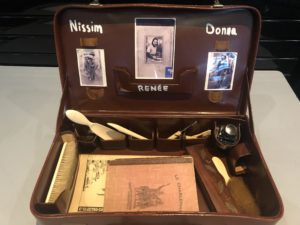
Renées “suitcase” as imagined by the students
After the CNRD competition, we wanted to invest even more in this project and devote a large part of our free time to it, or at least three of us did. We would have liked so much to learn more about their lives, but we came up against the silence of the sources! And we just had to accept that.
This role as investigators and witnesses that has been entrusted to us has become very important to us. However, in spite of our efforts, we were unable to find much information about the Elmales. Most of our research was unsuccessful because the various archives departments and people we contacted and/or met did not have many documents or much information about them. Also, at present, apart from Nissim’s sister, there are no known members of this family. We tried in every way possible to track her down in Turkey, or at least to find a trace of her children, given that she herself is probably no longer alive, but we were unable to do so.
Nevertheless, our modest contribution has made it possible, in a way, to undermine the Holocaust, since the Nazis’ intention was to erase all traces of the passage of the Jews on this earth. Now our biography of the Elmale family has been written and will be passed on for posterity.
The Auschwitz-Birkenau camp was liberated 76 years ago. Has everything been documented? A lot of things certainly. And yet negationism and denial have never been so widespread.
There are 12 memorial sites in France, but still… How can we avoid letting the victims be forgotten?
We are the last generation to be able to listen to survivors’ and witnesses’ testimonies. How could people commit such atrocities? What can we do to ensure that it never happens again?
“A dead man is only really dead when the last person who knew him dies” (Borges). “The dead are also the burden of history and of the past, with whom we are in endless dialogue. By forging links in the unending chain of humankind, we continue to keep the memory of the dead alive, awaiting the day when they, in turn, may help our passing“. Editorial from L’Histoire magazine, “Vivre avec les morts” (“Living with the dead”), July-August 2020.
It is thanks to projects such as that of “Convoy77” or memorial contests such as that of the CNRD that we do not forget what happened. It is in this way that the chain of humanity will not be broken and that the victims of the Holocaust will never fall into oblivion.
We echo the words of Mr. Meyer, president of the Convoy 77 association: “We are watchmen for the future!”
References:
- According to the documentary records provided by the Convoy 77 association at the beginning of the project.
- Thanks to an online request made to the Town Hall of the 12th district of Paris, we were able to obtain a copy of her birth certificate (in short form, i.e., not showing the parents’ names). We also found her name in the Paris online archives, in the list of births between 1923 and 1932.
- We found a trace of them (i.e. their names) in the 1931 population census of Enghien-les-Bains, in the Val-d’Oise departmental archives online.
- Her name appears in the list of successions and absences between 1937 and 1939 in the Val-d’Oise archives, as well as in the newspaper “Le Progrès de Seine-et-Oise”, dated February 28, 1937.
- Her photo can be found in the Shoah Memorial in Paris and the National Museum of Auschwitz-Birkenau.
- According to the book Enghien-les-Bains Kommandantur Val-d’Oise 1940-1945, Bruno Renoult, 2015.
- In the documents provided by the Convoy 77 association.
- According to the search receipt that we found on the Shoah Memorial website.
- We found their three departure records during a visit to Drancy.
Steps taken:
- February 2019: Emails sent to Fortunate Cambi’s granddaughter.
During our research, we wondered about the story of Fortunée Cambi, née Sévi, who was born in Constantinople in 1882. She emigrated to France with her husband in the 1910s. They had children who were born in the 12th district of Paris. They were also one of the families taken away on Convoy 77 and killed in the gas chambers on arrival in Auschwitz. Even though the name Sévi is widely known throughout the world, all this information has led us to believe that Fortunée Sévi was a member of the family of Donna Elmale née Sévi, in view of all the similarities between them. A cousin perhaps? We have therefore tried in many ways to confirm this hypothesis: emails sent to her granddaughter, phone calls, messages left on websites etc. Unfortunately, we did not get any definitive answers, so this is still just a hypothetical link.
the Elmale family tree
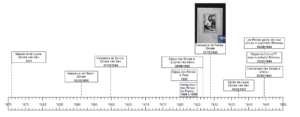
timeline
the families itinerary
- We created a family tree for part of the Elmale family and a map showing their movements throughout their lives. We also created two chronological friezes: one with the main historical facts about the Jews from Hitler’s coming to power until his death (facts cited throughout the biography) and another frieze with the known events about the Elmale family (births, movements etc.).
- Several mails sent to the archives in Turkey during the two years of research. Negative answers, given that Turkey has very few archived records.
- Message left on the AJPN site.
- Call to the civil registry department in Enghien-les-Bains. Calls to the Ormesson 2 school.
- Call to a person at the Villa de la Croix-Blanche in Enghien-les-Bains.
- 01/03/2019: Email sent to the library at the Shoah Memorial in Paris.
- 05/03/2019: Emails sent to Mr. Serge Jacubert, the son of a Convoy 77 deportee and member of the board of the association.
- 25/02/2020: Mail sent to the records department in Enghien-les-Bains.
- 13/05/2020: Online request for documents from the Yad Vashem Memorial in Israel.
- 25/05/2020: Email sent to the French consulate in Istanbul.
- 25/05/2020: Email sent to the Mayor of Enghien-les-Bains.
- 25/05/2020: Email sent to the Turkish embassy in Paris.
- 25/05/2020: Email sent to Yvelines departmental records office.
- 28/05/2020: Email sent to the Chief Rabbinate of Istanbul.
- 30/05/20: Email sent to a genealogical association.
- 11/06/2020: Letter sent to the Ministry for Europe and Foreign Affairs.
- 05/07/2020: Online request for documents from the Arolsen Archives.
Meetings, visits and trips:
- June 2019. Visit to the Natzweiler-Struthof concentration camp.
- Visit to Oradour-sur-Glane.
- 04/01/2019. Visit to the Shoah Memorial in Paris.
- 25/02/2019. Meeting with Frania Eisenbach Haverland, an extermination camp survivor. She was deported in 1941 and was liberated from Theresienstadt camp in Czechoslovakia in 1945. She is now ninety-four years old, but she continues to testify tirelessly to her story, which is directly connected with the Holocaust, so that this terrible period of history will never be forgotten. This survivor, whom we have seen several times (mainly during commemorations), has written a book entitled Tant que je vivrai (As long as I live). Her favorite phrase, which we have not forgotten, is “Never again!” Frania is an exceptional woman; she will be forever in our hearts and we will never forget her!
- 08/03/2019. Visit to the Drancy Camp national museum.
- 18/03/2019. Videoconference with five deportees (Ginette Kolinka, Esther Senot, Elie Buzin, Raphaël Esrail and Victor Perahia).
- From 30/10/2019 to 01/11/2019. Visit to Krakow and the Auschwitz-Birkenau camp. As a result of taking 3rd place in the CNRD contest, we won a trip to Poland. It was incredible. In spite of all the work done on the theme of deportation, we still learned things that we had never imagined. You have to see it to believe it. It is extremely difficult to realize the barbarity of these people who put their fellow human beings through such atrocities. Such genocide is unimaginable and too unspeakable to describe. No matter how many visits you make to concentration and extermination camps, they will never replace the sense of terror and inhuman torture that would have reigned there.
- 05/10/2019. Memorial ceremony for the victims of Aincourt internment camp
___________________________________________________________________________________________________________________________________
Pictures taken during a trip to Poland – Auschwitz-Birkenau museum
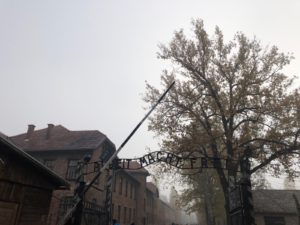
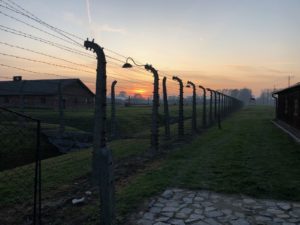
Links:
- https://convoi77.org/
- http://www.ajpn.org/
- https://www.reseau-canope.fr/cnrd/
- https://www.geneanet.org/
- https://www.enghienlesbains.fr/
- fondationshoah.org
Thanks
We would like to thank all those who helped us with our research, as well as all the concentration camp survivors we were lucky enough to meet. We also thank our teacher, Ms. Le Bihan-Buannec, who devoted a lot of her time and always supported us. Finally, we thank the Convoy 77 association enormously! Thank you for providing us with the archive material and for letting us participate in this fundamental duty to remember!
Contributor(s)
Students from the Chabanne junior high school in Pontoise, under the supervision of their history, geography and moral and civic education teacher, Ms. Le Bihan-Buannec.


 Français
Français Polski
Polski








